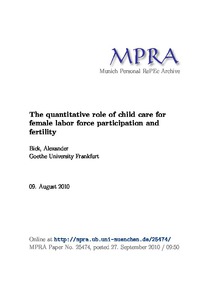The quantitative role of child care for female labor force participation and fertility
"Consistent with facts for a cross-section of OECD countries, I document that the labor force participation rate of West German mothers with children aged zero to two exceeds the corresponding child care enrollment rate whereas the opposite is true for mothers with children aged three to mandat...
| Main Author: | |
|---|---|
| Institution: | ETUI-European Trade Union Institute |
| Format: | TEXT |
| Language: | English |
| Published: |
Munich
2010
MPRA |
| Subjects: | |
| Online Access: | https://www.labourline.org/KENTIKA-19183600124919018829-The-quantitative-role-of-child.htm |
| Summary: | "Consistent with facts for a cross-section of OECD countries, I document that the labor force participation rate of West German mothers with children aged zero to two exceeds the corresponding child care enrollment rate whereas the opposite is true for mothers with children aged three to mandatory school age. I develop a life-cycle model that explicitly accounts for this age-dependent relationship through various types of non-paid and paid child care. The calibrated version of the model is used to evaluate two recently passed policy reforms concerning the supply of subsidized child care for children aged zero to two in Germany. These counterfactual policy experiments suggest that the lack of subsidized child care constitutes indeed for some females a barrier to participate in the labor market and depresses fertility." |
|---|---|
| Physical Description: | 58 p. Digital |

